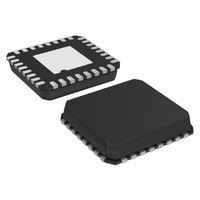AD7626BCPZ Analog Devices Inc, AD7626BCPZ Datasheet - Page 14

AD7626BCPZ
Manufacturer Part Number
AD7626BCPZ
Description
IC ADC 16BIT 10MSPS DIFF 32LFCSP
Manufacturer
Analog Devices Inc
Datasheet
1.AD7626BCPZ-RL7.pdf
(28 pages)
Specifications of AD7626BCPZ
Data Interface
Serial
Design Resources
Single-Ended-to-Differential High Speed Drive Circuit for 16-Bit, 10 MSPS AD7626 ADC (CN0105)
Number Of Bits
16
Sampling Rate (per Second)
10M
Number Of Converters
1
Power Dissipation (max)
170mW
Voltage Supply Source
Single Supply
Operating Temperature
-40°C ~ 85°C
Mounting Type
Surface Mount
Package / Case
32-VFQFN, CSP Exposed Pad
Resolution (bits)
16bit
Sampling Rate
10MSPS
Input Channel Type
Differential
Supply Current
23.5mA
Digital Ic Case Style
CSP
No. Of Pins
32
Lead Free Status / RoHS Status
Lead free / RoHS Compliant
Available stocks
Company
Part Number
Manufacturer
Quantity
Price
Company:
Part Number:
AD7626BCPZ
Manufacturer:
ADI
Quantity:
263
Part Number:
AD7626BCPZ
Manufacturer:
ADI/亚德诺
Quantity:
20 000
Company:
Part Number:
AD7626BCPZ-RL7
Manufacturer:
PERICOM
Quantity:
101
Part Number:
AD7626BCPZ-RL7
Manufacturer:
ADI/亚德诺
Quantity:
20 000
AD7626
TERMINOLOGY
Common-Mode Rejection Ratio (CMRR)
CMRR is defined as the ratio of the power in the ADC output
at full-scale frequency, f, to the power of a 100 mV p-p sine
wave applied to the common-mode voltage of V
at frequency, f
where:
Pf is the power at frequency, f, in the ADC output.
Pf
Differential Nonlinearity (DNL) Error
In an ideal ADC, code transitions are 1 LSB apart. Differential
nonlinearity is the maximum deviation from this ideal value. It
is often specified in terms of resolution for which no missing
codes are guaranteed.
Integral Nonlinearity (INL) Error
Linearity error refers to the deviation of each individual code
from a line drawn from negative full scale through positive full
scale. The point used as negative full scale occurs ½ LSB before
the first code transition. Positive full scale is defined as a level
1½ LSB beyond the last code transition. The deviation is meas-
ured from the middle of each code to the true straight line.
Dynamic Range
Dynamic range is the ratio of the rms value of the full scale to
the rms noise measured for an input typically at −60 dB. The
value for dynamic range is expressed in decibels.
Effective Number of Bits (ENOB)
ENOB is a measurement of the resolution with a sine wave
input. It is related to SINAD and is expressed in bits by
Gain Error
The first transition (from 100 … 000 to 100 …001) should occur
at a level ½ LSB above nominal negative full scale (−4.0959375 V
for the ±4.096 V range). The last transition (from 011 … 110 to
011 … 111) should occur for an analog voltage 1½ LSB below
the nominal full scale (+4.0959375 V for the ±4.096 V range).
The gain error is the deviation of the difference between the
actual level of the last transition and the actual level of the first
transition from the difference between the ideal levels.
Gain Error Drift
The ratio of the gain error change due to a temperature change
of 1°C and the full-scale range (2
million.
Least Significant Bit (LSB)
The least significant bit, or LSB, is the smallest increment that
can be represented by a converter. For a fully differential input
ADC with N bits of resolution, the LSB expressed in volts is
S
is the power at frequency, f
CMRR (dB) = 10 log(Pf/Pf
ENOB = [(SINAD
LSB
(V) =
S
.
V
2
INp-p
N
dB
− 1.76)/6.02]
S
, in the ADC output.
S
)
N
). It is expressed in parts per
IN+
and V
IN−
Rev. A | Page 14 of
Power Supply Rejection Ratio (PSRR)
Variations in power supply affect the full-scale transition but not
the linearity of the converter. PSRR is the maximum change in
the full-scale transition point due to a change in power supply
voltage from the nominal value.
Reference Voltage Temperature Coefficient
The reference voltage temperature coefficient is derived from the
typical shift of output voltage at 25°C on a sample of parts at the
maximum and minimum reference output voltage (V
ured at T
where:
V
V
V
T
T
Signal-to-Noise Ratio (SNR)
SNR is the ratio of the rms value of the actual input signal to
the rms sum of all other spectral components below the Nyquist
frequency, excluding harmonics and dc. The value for SNR is
expressed in decibels.
Signal-to-(Noise + Distortion) Ratio (SINAD)
SINAD is the ratio of the rms value of the actual input signal to
the rms sum of all other spectral components below the Nyquist
frequency, including harmonics but excluding dc. The value for
SINAD is expressed in decibels.
Spurious-Free Dynamic Range (SFDR)
SFDR is the difference, in decibels, between the rms amplitude
of the input signal and the peak spurious signal (including
harmonics).
Total Harmonic Distortion (THD)
THD is the ratio of the rms sum of the first five harmonic
components to the rms value of a full-scale input signal and
is expressed in decibels.
Zero Error
Zero error is the difference between the ideal midscale input
voltage (0 V) and the actual voltage producing the midscale
output code.
Zero Error Drift
The ratio of the zero error change due to a temperature change
of 1°C and the full scale code range (2
per million.
MAX
MIN
REF
REF
REF
(Max) = maximum V
(Min) = minimum V
(25°C) = V
= −40°C.
TCV
= +85°C.
MIN
REF
, T(25°C), and T
(
ppm/
REF
°
at 25°C.
C
)
=
V
REF
REF
REF
V
REF
MAX
at T
(
at T
25
(
. It is expressed in ppm/°C as
Max
°
MIN
MIN
C
)
, T(25°C), or T
, T(25°C), or T
– )
×
N
T (
). It is expressed in parts
V
REF
MAX
(
–
Min
T
MIN
)
MAX
)
MAX
×
REF
10
.
.
) meas-
6













